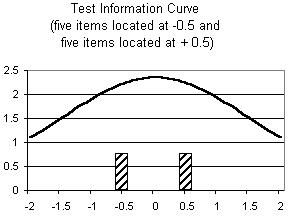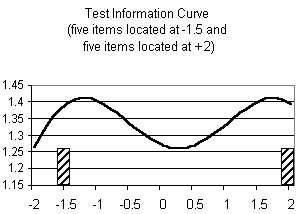Item Information: When Gaps Can Be Bridged
Fit of data to the Rasch model always makes us feel comfortable.
While fit provides evidence of accuracy of the measurement model of
the variable of interest, precision, however, is a different issue,
namely the issue of targeting. (Strictly speaking, mistargeting
also affects the power of the test of fit.) If items are
operational in a range of the latent dimension but most of the
respondents are located in a different range, person (and item)
parameter estimates lack precision and standard errors are large.
The reason, of course, is that the further apart an item and a
person is, the less information the item provides about the
location of the person, with item information being calculated as
P*(1-P) (Fischer, 1974, p.294). Over the items in a test,
individual item information adds up to test information (Fischer,
1974, p.296). The test information curve typically but not
necessarily is bell-shaped with its maximum at 0 (provided the
scale has been defined by the sum of items equal to 0).
An interesting variant of mistargeting occurs when items are
clustered in terms of their location and most or many persons are
between the clusters (see Figure 1).

Figure 1: Distribution of Person and Item Locations (Produced by RUMM2020 (Andrich et al., 2003), simulated data) |

Figure 2: Test Information Curve for five items located at -0.5 and five items located at + .5. |

Figure 3: Test Information Curve for five items located at -1.5 and five items located at + .1.5. |

Figure 4: Test Information Curve for five items located at -1.5and five items located at + 2.0. |
Let us assume that, for simplicity, in a ten item test, five
dichotomous items are located exactly at -0.5 and five other items
are located at 0.5 on a logit scale. (Assuming that there are no
further items below -.5 and above +.5 does not have a substantial
impact on the conclusions drawn.) In other words, there is a gap
between these item clusters. Intuitively, one might think that
information is higher at -0.5 and at 0.5, respectively, than
between -0.5 and 0.5 due to the gap between item locations.
However, in most cases, the gap between items does not imply less
information. On the contrary, information peaks out right in the
middle of the gap, i.e. at 0 (with 2.35 of total test information
in the given example). At the centers of either item cluster,
information only amounts to 2.23 (see Figure 2).
The explanation is that, though, information reaches its maximum
at ξ (person ability) = δ (item difficulty) with .5 * (1
- .5) = .25, it remains rather high over a relatively wide range.
At |ξ - δ| = .5 it still is .235 and at |ξ - δ|
= 1 it amounts to .197. While information is reduced when moving
from ξ = δ to |ξ - δ| = 1 by .053 points, the
rate of decrease almost doubles for a further logit unit between x
and d with information being only .105 at |ξ - δ| = 2.
Consequently, in our example, when moving from -.5 into the gap
between -.5 and +.5 we loose information provided by the items
clustered at -.5. But at the same time we gain information by the
items clustered at +.5. For a person location of, e.g., -.2 we
loose .006 per item clustered at -.5 whereas we gain .025 from
items located at +.5, i.e. four times as much. In other words,
total information increases. Thus, we get the same bell-shaped
information curve even though there is a gap. It should be noted
that in terms of interpretation of person locations within the gap,
the lack of items located in this range is certainly not
satisfactory.
It is interesting to compare the situation with a Guttman scale.
If the items would function perfectly all persons within the gap
would get all the five items at -.5 right and all the five items at
+.5 wrong. There would be no way to tell whether a particular
person is closer to -.5 or to +.5. So, it is the stochastic
uncertainty under the Rasch model, the "imperfect nature" so to
speak, that yields information and, as a consequence,
precision.
However, not all gaps can be bridged. If the distance between
the item clusters is too large, the loss of information from "near"
items when moving into the center of the gap is not compensated for
by the gain of information from "distant" items. The result is a
double-peaked total information curve (see Figures 3 and 4).
Thomas Salzberger
Vienna University of Economics
and Business Administration, Austria
The author wants to thank Alan Tennant (University of Leeds) and
David Andrich (Murdoch University) for the stimulating input they
provided.
Andrich, D.; Lyne, A.; Sheridan, B.; Luo, G. (2003): RUMM2020,
v. 4.0, Rumm Laboratory.
Fischer, Gerhard (1974): Einführung in die Theorie
psychologischer Tests [Introduction to the Theory of Psychological
Tests], Huber, Bern.
Item Information: When Gaps Can Be Bridged. Thomas Salzberger … Rasch Measurement Transactions, 2003, 17:1, 910-911.



